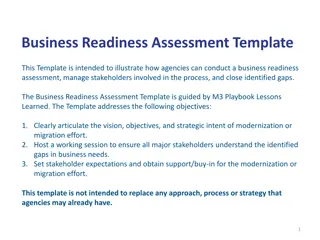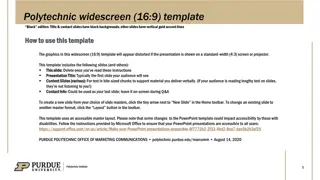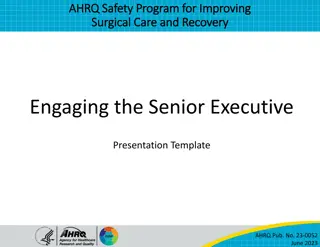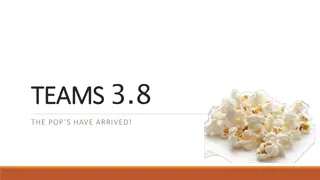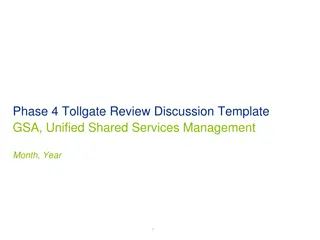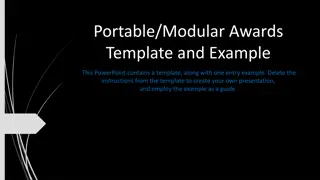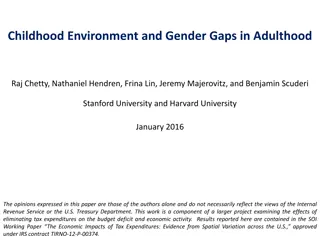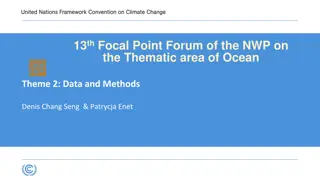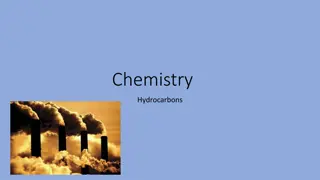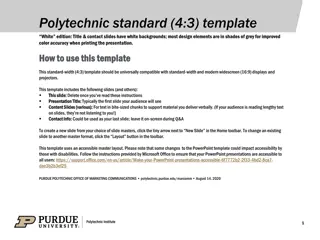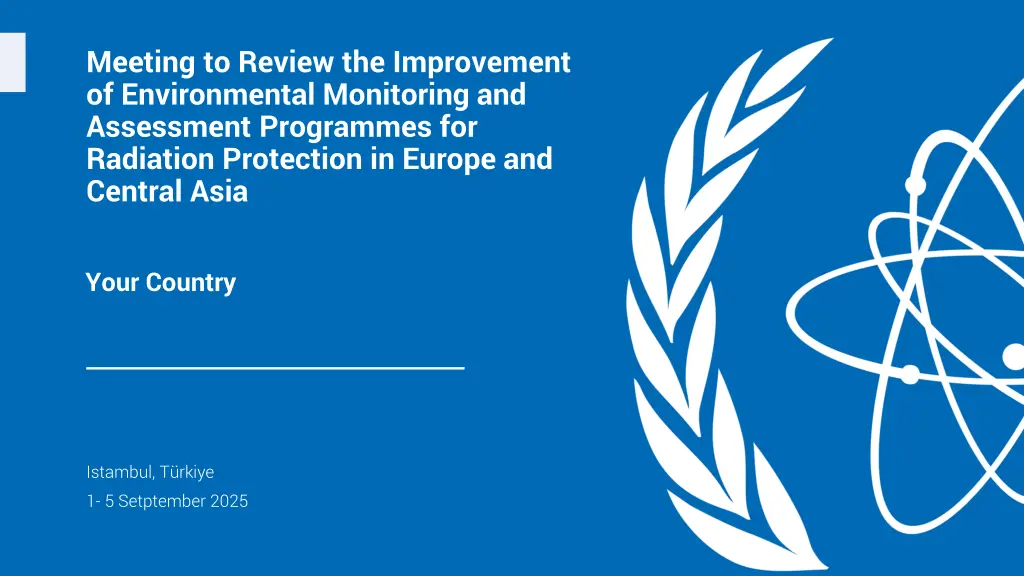
Improvement of Environmental Monitoring and Assessment Programmes for Radiation Protection
Explore how Turkey has enhanced its national analytical capabilities and environmental monitoring programmes over the past five years, focusing on various analyses of environmental samples and monitoring parameters. Discover the need for further assistance in developing and improving capabilities for radiation protection.
Download Presentation

Please find below an Image/Link to download the presentation.
The content on the website is provided AS IS for your information and personal use only. It may not be sold, licensed, or shared on other websites without obtaining consent from the author. If you encounter any issues during the download, it is possible that the publisher has removed the file from their server.
You are allowed to download the files provided on this website for personal or commercial use, subject to the condition that they are used lawfully. All files are the property of their respective owners.
The content on the website is provided AS IS for your information and personal use only. It may not be sold, licensed, or shared on other websites without obtaining consent from the author.
E N D
Presentation Transcript
Meeting to Review the Improvement of Environmental Monitoring and Assessment Programmes for Radiation Protection in Europe and Central Asia Your Country Istambul, T rkiye 1- 5 Setptember 2025
National Analytical Capabilities Please indicate whether, and describe how, your country has improved its capability and infrastructure over the past five years to conduct the following analyses of environmental samples: Gross Alpha / Beta Liquid scintillation High-resolution gamma spectrometry Alpha spectrometry Other 2
Environmental Monitoring Programmes Please indicate whether, and describe how, your country has improved its capability and infrastructure over the past five years to monitor in the environment one or more of these parameters: Gamma Dose Rate Freshwater non-human species Airborne Particulates Seawater Dry Deposition Marine Sediments Wet Deposition Marine non-human species Groundwater Drinking water Soil Milk Terrestrial non-human species Other foodstuffs Surface fresh water Mixed Diet Fresh water Sediments Radon 3
Environmental Monitoring Programmes Please indicate if your country would need further assistance to develop/improve capabilities to monitor one or more of these parameters: Gamma Dose Rate Freshwater non-human species Airborne Particulates Seawater Dry Deposition Marine Sediments Wet Deposition Marine non-human species Groundwater Drinking water Soil Milk Terrestrial non-human species Other foodstuffs Surface fresh water Mixed Diet Fresh water Sediments Radon 4
Resources for Improvements For those parameters / analytical capabilities which have improved in the past 5 years, indicate if these improvements involved acquisition of equipment, training/ capacity building and when applicable, the sources of funding. Describe events attended and their impact in the capability building, describe the equipment acquired, etc. 5
Further Improvements in Environmental Monitoring Would your country need further assistance to keep improving the national analytical capability or the environmental monitoring programmes? Have you identified the type of assistance your country might need, and how this could be delivered through the TC project? 6
Regulatory Infrastructure Among the common regulatory gaps identified across the region, please select and describe the most relevant to your country: 1. Training and Human Resources : 1. Training and Human Resources : o Lack of training for regulatory staff and experts in monitoring. Lack of training for regulatory staff and experts in monitoring. Need for capacity building in monitoring programme design, dose assessment, and emergency preparedness. Need for capacity building in monitoring programme design, dose assessment, and emergency preparedness. o Shortage of trained personnel, particularly in small regulatory bodies. Shortage of trained personnel, particularly in small regulatory bodies. o 2. Establishment or Strengthening of National Monitoring Programmes: 2. Establishment or Strengthening of National Monitoring Programmes: Absence or inadequacy of a National Environmental Monitoring Programmes. Absence or inadequacy of a National Environmental Monitoring Programmes. o Need for a more comprehensive and harmonized monitoring strategy. Need for a more comprehensive and harmonized monitoring strategy. o Need to optimize resources by avoiding overlapping responsibilities among multiple institutions. Need to optimize resources by avoiding overlapping responsibilities among multiple institutions. o 3 3. Guidance and Frameworks for Monitoring Programmes: . Guidance and Frameworks for Monitoring Programmes: Lack of specific guidance for designing and reviewing monitoring programmes. Lack of specific guidance for designing and reviewing monitoring programmes. o Missing regulations or clarity on monitoring Missing regulations or clarity on monitoring for different exposure situations e.g. decommissioning activities. decommissioning activities. for different exposure situations e.g. authorized practices, existing exposures, or authorized practices, existing exposures, or o Inconsistent application of the graded approach in monitoring requirements. Inconsistent application of the graded approach in monitoring requirements. o 7
Regulatory Infrastructure 4. Laboratory Authorization, Accreditation, and Oversight: 4. Laboratory Authorization, Accreditation, and Oversight: Gaps in requirements for laboratory authorization, ISO 17025 accreditation, and inter Gaps in requirements for laboratory authorization, ISO 17025 accreditation, and inter- -laboratory comparison exercises. exercises. laboratory comparison o Need to establish clear quality control programs for monitoring results. Need to establish clear quality control programs for monitoring results. o Concerns over sustainability of laboratory techniques for low Concerns over sustainability of laboratory techniques for low- -use but critical analyses (e.g., alpha spectrometry). spectrometry). use but critical analyses (e.g., alpha o 5 5. Monitoring of Specific Environmental Components: . Monitoring of Specific Environmental Components: Lack of food and drinking water monitoring regulations. Lack of food and drinking water monitoring regulations. o Inadequate framework for monitoring discharges from authorized practices. Inadequate framework for monitoring discharges from authorized practices. o Sparse or inconsistent monitoring of radon, biota, and NORM practices. Sparse or inconsistent monitoring of radon, biota, and NORM practices. o 6 6. Data Management and Exchange: . Data Management and Exchange: Lack of a centralized national database for monitoring results. Lack of a centralized national database for monitoring results. o Inconsistent data exchange mechanisms between regulatory bodies, laboratories, and international partners. Inconsistent data exchange mechanisms between regulatory bodies, laboratories, and international partners. o Absence of frameworks for data quality management and cybersecurity. Absence of frameworks for data quality management and cybersecurity. o 8
Regulatory Infrastructure 7. Emergency Monitoring and Decision Support: 7. Emergency Monitoring and Decision Support: Lack of emergency response monitoring strategies. Lack of emergency response monitoring strategies. o Insufficient support for decision Insufficient support for decision- -making in emergencies due to poor integration of monitoring data. making in emergencies due to poor integration of monitoring data. o Need to expand and automate gamma dose rate monitoring networks. Need to expand and automate gamma dose rate monitoring networks. o 8. Regulatory and Legal Framework Strengthening: 8. Regulatory and Legal Framework Strengthening: Need for updated and harmonized regulations aligning with IAEA and EU standards. Need for updated and harmonized regulations aligning with IAEA and EU standards. o Undefined responsibilities in dose assessment, remediation, and long Undefined responsibilities in dose assessment, remediation, and long- -term monitoring. term monitoring. o Gaps in regulatory provisions for decommissioning and waste disposal monitoring. Gaps in regulatory provisions for decommissioning and waste disposal monitoring. o . 9
Regulatory Infrastructure Improvements Would your country need further assistance to address these regulatory gaps? Have you identified the type of assistance your country might need, and how this could be delivered through the TC project? 10



